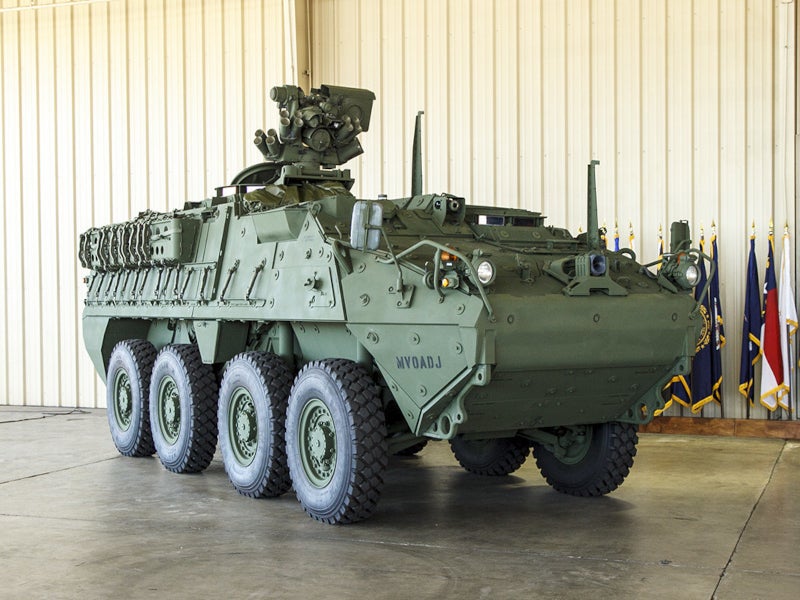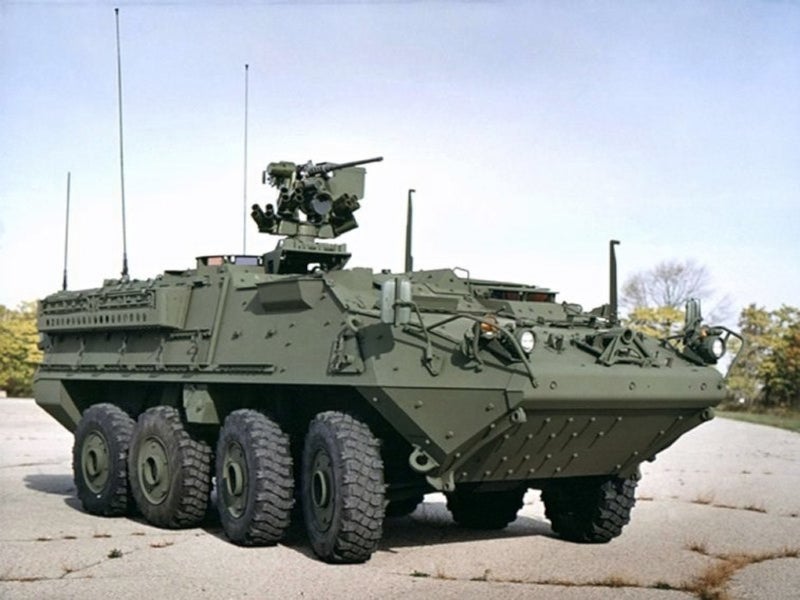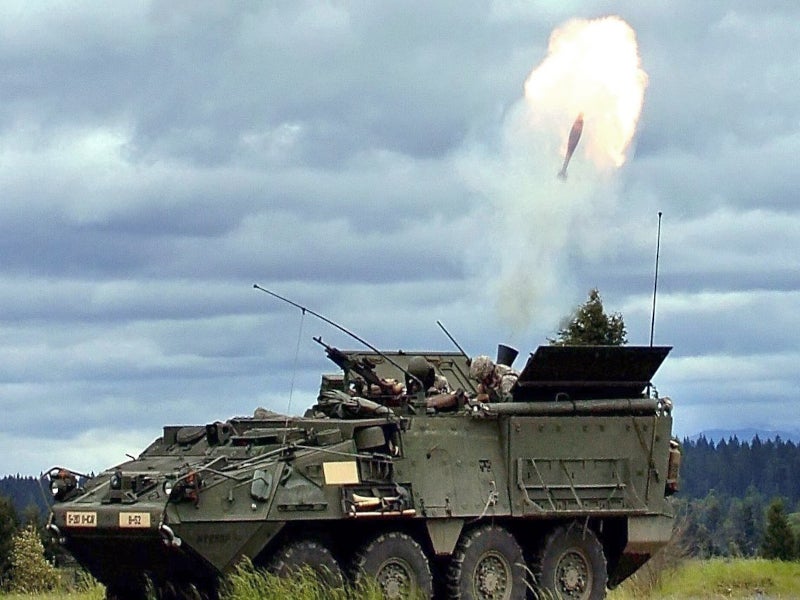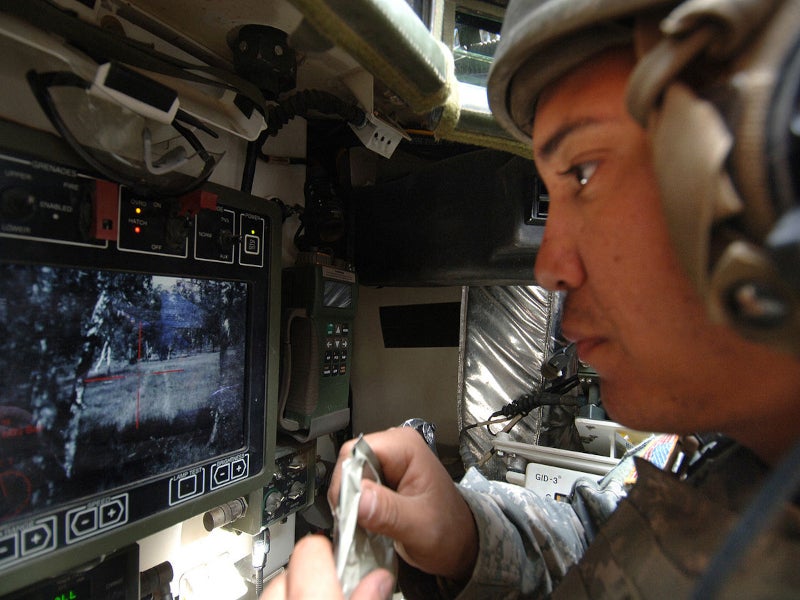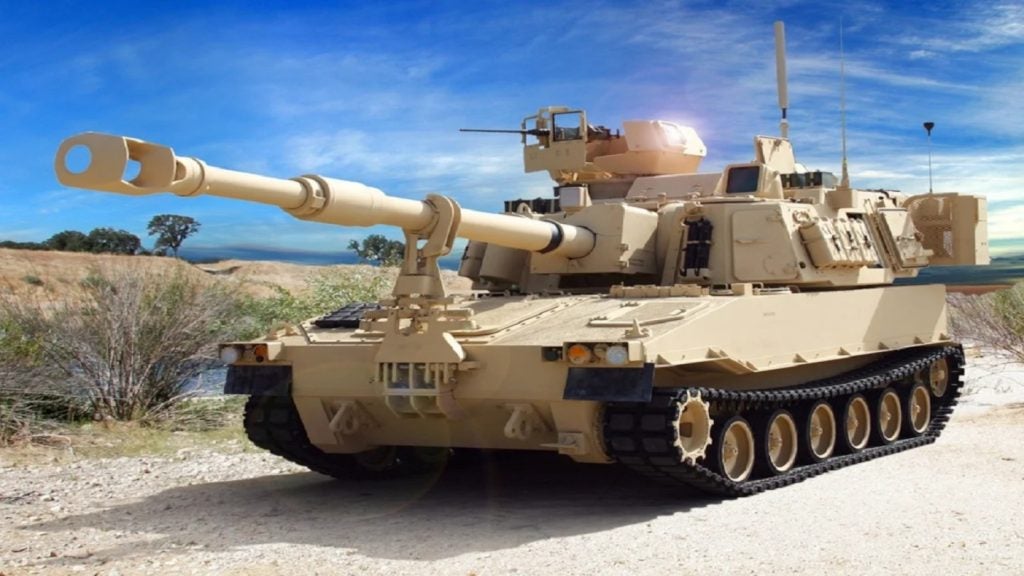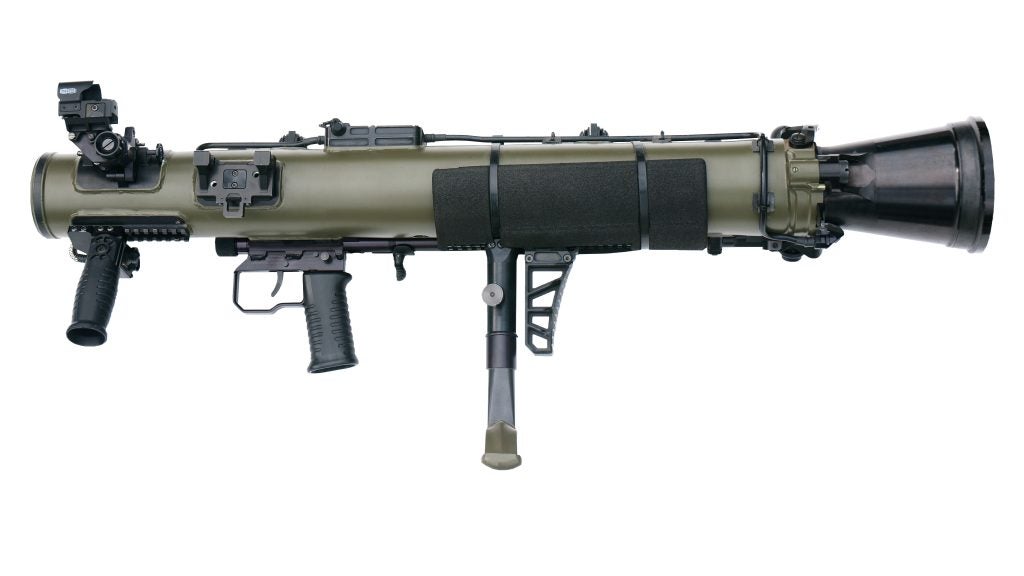Understand the impact of the Ukraine conflict from a cross-sector perspective with the Global Data Executive Briefing: Ukraine Conflict
Stryker is a family of eight-wheel-drive combat vehicles built for the US Army by General Dynamics Land Systems (GDLS) – Canada and the General Dynamics Land Systems Division, US.
Stryker is available in ten variants, including infantry carrier vehicle, commander’s vehicle, medical evacuation vehicle, fire support vehicle, engineer squad vehicle, anti-tank guided missile carrier, mortar carrier, reconnaissance vehicle, mobile gun system, and nuclear, biological and chemical reconnaissance (NBCR) vehicle.
The vehicle is based on the GDLS Canada LAV III 8×8 light armoured vehicle, in service since early 2001. The LAV III itself is a version of the Piranha III built by Mowag of Switzerland, now part of GDLS – Europe.
The eight-wheeled Stryker armoured combat vehicle is the first new military vehicle to enter service into the US Army since the Abrams tank in the 1980s.
Fabrication and final assembly of the vehicles were shared among plants at Anniston, Alabama, Lima, Ohio and London, Ontario. The vehicles were upgraded with double-V hull (DVH) to provide soldiers with additional protection against mines and improvised explosive devices (IEDs).
Stryker brigade combat team (SBCT)
The Stryker brigade combat team (SBCT) combines the capacity for rapid deployment with survivability and tactical mobility. The Stryker armoured combat vehicle enables the team to manoeuvre in close and urban terrain, provide protection in open terrain and transport infantry quickly to critical battlefield positions.
The contract for the US Army’s interim armoured vehicle (IAV) was awarded in November 2000. The vehicles formed the basis of six brigade combat teams. The contract requirement covered the supply of 2,131 vehicles.
Stryker infantry carrier development
Deliveries of Stryker infantry carriers began in April 2002. Initial operational tests and evaluation began in May 2003 with the Arrowhead Lightning II exercise. Since 2003, the vehicles have undergone more than six million miles in service through two Operational Iraqi Freedom rotations, demonstrating a combined fleet operational readiness rate of 96%.
In November 2003, the Stryker armoured combat vehicle entered operational service with the US Army, with the first Stryker SBCT, 3rd Brigade, 2nd Infantry Division, following its deployment to Iraq. The second SBCT, 1st Brigade, 25th Infantry Division, was deployed to Iraq in September 2004. The third SBCT, the 172nd, deployed in July 2005.
Stryker armour upgrades
In March 2005, United Defense (now BAE Systems Land and Armaments) was awarded a contract to provide 289 full-vehicle add-on reactive armour kits for the Stryker. The US Army awarded a $30m contract in July 2010 to GDLS to produce a dual V-shaped hull for the Stryker infantry combat vehicle which was completed by February 2012.
In December 2010, GDLS was awarded with a $9.6m contract by the US Army to supply 350 Strykers with electronic video display kits, while another $9.9m contract was awarded for the procurement and installation of Stryker shields.
GDLS received a $163m contract to convert 93 flat-bottom Stryker infantry combat vehicles to the improved DVH design by the US Army in May 2014. Further, the US Army provided a $258m contract modification to GDLS to upgrade 116 Stryker flat-bottom Stryker vehicles to the Stryker A1 configuration in June 2018. Besides the DVH design, the Stryker A1 configuration also features a 450-horsepower engine, 60,000-pound suspension, 910-amp alternator and in-vehicle network. The company received another $383m contract modification to upgrade additional 173 Stryker flat-bottom vehicles to the A1 configuration in October 2018.
The US Army is also modifying the Stryker vehicles with sensors and weapons to meet the requirements of an interim Manoeuvre-Short-Range Air Defence (M-SHORAD).
Stryker medical evacuation vehicle (MEV)
During March 2009, the Stryker medical evacuation vehicle (MEV), the new ambulance variant, was deployed by the US Army. According to an army transformation strategy, 30 MEVs were delivered to the 3rd Infantry Division’s 3rd Heavy Brigade Combat Team to be deployed in the
Middle East. The vehicle was on display at the Garfield Circle, Washington DC, on March 23-24, 2009.
The US Army TACOM awarded a contract worth $55.2m to General Dynamics Land Systems to reset 330 Stryker infantry combat vehicles in July 2009.
Under this contract, the Stryker vehicles returning from Operation Iraqi Freedom were serviced, repaired and modified, returning them to a like-new condition before further deployment.
The US Army TACOM signed a contract worth $647m with GDLS for the supply of 352 Stryker vehicles in October 2009. US Army TACOM ordered 450 DVH Stryker vehicles in July 2010. More than 300 vehicles were delivered by October 2011.
In October 2011, GDLS was awarded a $243m contract by US Army TACOM to supply 115 DVH Stryker vehicles by September 2012. Additional 177 DVH Stryker vehicles were also ordered under a $367m contract placed in the same month of 2011.
Stryker variants
Stryker variants include the M1126 infantry carrier vehicle (ICV) and the M1128 mobile gun system (MGS).
Other configurations of the ICV include the M1135 nuclear, biological, chemical reconnaissance vehicle (NBC RV), M1134 anti-tank guided missile (ATGM), M1133 medical evacuation vehicle (MEV), M1129 mortar carrier (MC), M1132 engineer squad vehicle (ESV), M1130 command vehicle (CV), M1131 fire support vehicle (FSV) and the M1127 reconnaissance vehicle (RV).
The reconnaissance vehicle is fitted with the Raytheon long-range advanced scout surveillance system (LRAS3). The system includes a second-generation horizontal technology initiative (HTI) thermal imager, day TV and eye-safe laser rangefinder. The US Army is to enhance the system by lengthening the sensor mast to 10m, increasing the range to 10km.
The mortar carrier (MCV-B) entered service in August 2005. The MCV-B’s 120mm mortar is mounted inside the vehicle and fires through doors that swing open at the top of the vehicle. As well as the mounted mortar, the vehicle carries a second mortar which must be unloaded before firing. The vehicle has a digital fire control system and a crew of five.
The first of 17 LRIP nuclear, biological, chemical reconnaissance vehicle (NBC RV) variants was delivered in December 2005. The system can collect and automatically integrate contamination information with vehicle navigation and meteorological sensor data and then transmit digital warning messages to other forces.
The US Army placed a contract for 33 medical evacuation vehicles (MEV) in September 2007. The MEV can accommodate up to six patients and a medical team.
Stryker infantry carrier vehicle details
The Stryker is a full-time four-wheel drive, selectively eight-wheel drive, armoured vehicle weighing approximately 19t. The vehicle can attain speeds of 100km/h (62mi/h) on metalled roads and has a maximum range of 502km (312mi).
The basic infantry carrier vehicle (ICV) provides armoured protection for the two-man crew and a squad of nine infantry soldiers. The basic hard steel armour is augmented by applique panels of lightweight ceramic/composite armour produced by a team led by IBD / Deisenroth Engineering of Germany.
The armour provides integral all-round 14.5mm protection against machine gun rounds, mortar and artillery fragments. In Iraq, in January 2004, Stryker vehicles were outfitted with a ‘cage’ of slat armour, which encircles the vehicle about 18in from the main body, as protection against rocket-propelled grenades (RPGs).
Stryker armoured combat vehicle weapons and self-protection
The ICV has a protector remote weapon station, from Kongsberg Protech of Norway, with a universal soft mount cradle, which can mount either a 0.50-calibre M2 machine gun, MK19 40mm grenade launcher or MK240 7.62mm machine gun. It is also armed with four M6 smoke grenade launchers.
In August 2005, Kongsberg awarded BAE Systems a contract to supply the TIM1500 640×480 uncooled thermal imaging camera for the remote weapon station.
The vehicle’s commander has an FBCB2 (force XXI battle command brigade and below) digital communications system that allows communication between vehicles through text messaging and a map network, as well as with the battalion.
The map shows the position of all vehicles on the battlefield and the commander can mark the position of enemy forces on the map which can then be seen by other commanders. FBCB2, ‘the tactical internet’, includes the Raytheon AN/TSQ-158 enhanced position location reporting system (EPLRS).
The Stryker driver has three M-17 periscopes and a DRS Technologies AN/VAS-5 driver’s vision enhancer (DVE). The vehicle commander has seven M45 periscopes and a thermal imager display with video camera.
In February 2009, BAE Systems was awarded a production contract for the Check-6 thermal imaging driver’s rear-view camera (DRVC) system for the Stryker ICV. The system is fitted to the vehicle’s taillight housing. Deliveries began in April 2009.
Stryker mobile gun system
Eight pre-production Stryker mobile gun systems were delivered to the US Army between July 2002 and March 2003. Low-rate initial production (LRIP) of 72 additional mobile gun variants went underway at General Dynamics Anniston facility. The first was delivered in December 2005.
The MGS entered service with the US Army in May 2007, with the first operational deployment to Iraq with the 4th brigade, 2nd Division.
By November 2007, three Stryker brigades had received the MGS. A production contract for 62 vehicles was placed in August 2008.
Stryker MGS was selected by the Canadian Army, which planned to acquire 66 systems to replace Leopard 1 tanks. However, it was decided to acquire surplus Leopard 2 tanks instead.
The Stryker mobile gun system variant consists of the basic vehicle with a General Dynamics Land Systems fully stabilised shoot-on-the-move low-profile turret.
The turret is armed with a M68A1E4 105mm cannon with muzzle brake and an M2 0.50-calibre commander’s machine gun.
The Stryker mobile gun system can fire 18 rounds of 105mm main gun ammunition, 400 rounds of 0.50-calibre ammunition and 3,400 rounds of 7.62mm ammunition.
Curtiss-Wright Corp’s Vista Controls supplies the fully automated ammunition loading and replenishing system. Two M6 smoke grenade launchers are also fitted.
The mobile gun system has the same C4ISR communications and driver’s vision equipment as the ICV, but the gunner has three periscopes and a compact modular sight with dual field of view day and thermal channels.
The MGS also has detectors for nuclear, biological and chemical weapons.
An advantage to the brigade combat teams in having the mobile gun vehicle of the same Stryker family of vehicles is the commonality across the entire capability and the reduced logistics requirement.
The Stryker mobile gun does not require a track-vehicle mechanic as would be required for example for the deployment of an M-8 mobile armoured gun system.
Transportation
Stryker can be transported on the ground using trucks or by air on C-17, C-5 and C-130 aircraft. The C-5 and C-17 aircraft can carry seven and four Strykers respectively.
The C-130H can fly safely carrying a maximum 38,000lb load for up to 1,000nm. The Stryker’s weight, 36,240lb and size are within the payload limit of the C-130H. The C-130 can operate from smaller airfields in more remote locations. All configurations of the Stryker can disembark from the C-130 in combat-ready status.
Orders and deliveries of Stryker armoured combat vehicle
Contracts for 328 vehicles to form the 4th Brigade were placed in March / June 2004 for delivery during 2005 and 2006, plus 423 vehicles for the 5th Brigade in February 2005 with deliveries in 2006-07.
306 Strykers were ordered in April 2006, 103 in July 2006 and 109 in October 2006, while 615 Stryker vehicles were ordered in August 2008. The Pennsylvania Army National Guard’s 56th Stryker Brigade Combat Team, the only National Guard SBCT, deployed to Iraq in February 2009. The 5th Stryker Brigade was deployed to Afghanistan in mid-2009, the first SBCT to do so.
The first US Air Force Stryker unit made its first deployment in Iraq in August 2005. In December 2008, the Iraqi Government requested the foreign military sale (FMS) of 400 Stryker infantry carrier vehicles.
In March 2009, a contract worth $4.8m to produce 805 Stryker driver enhancement kits was awarded to JWF Defense Systems by General Dynamics Land Systems – Canada. The deliveries were completed between April and June 2009.
Thailand requested to buy 60 Stryker infantry carrier vehicles as well as associated equipment for an estimated cost of $175m in July 2019.
GDLS received a $1.21ubn contract to produce, test and deliver Interim Manoeuvre Short-Range Air Defence (IM-SHORAD) systems to the US Army in October 2020.

